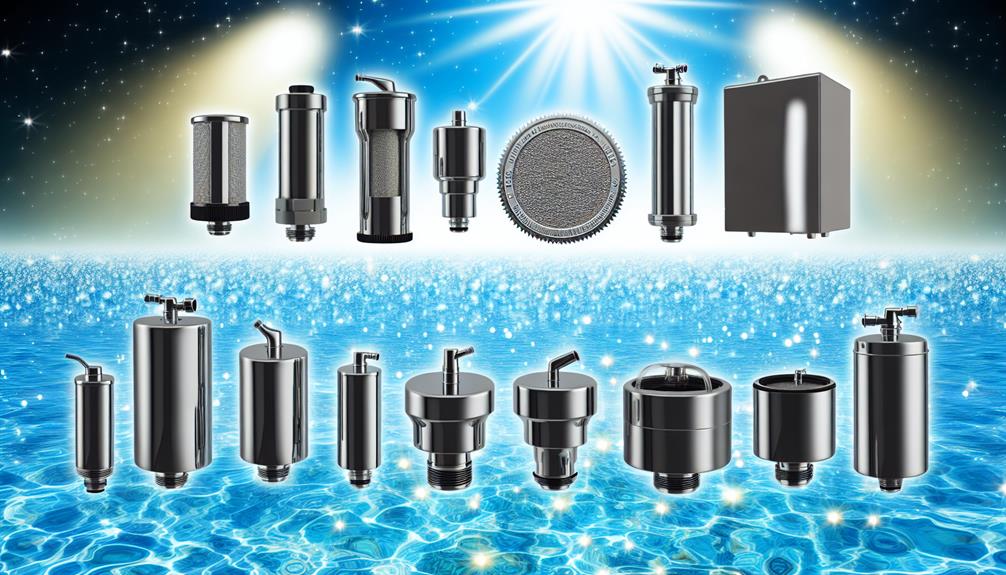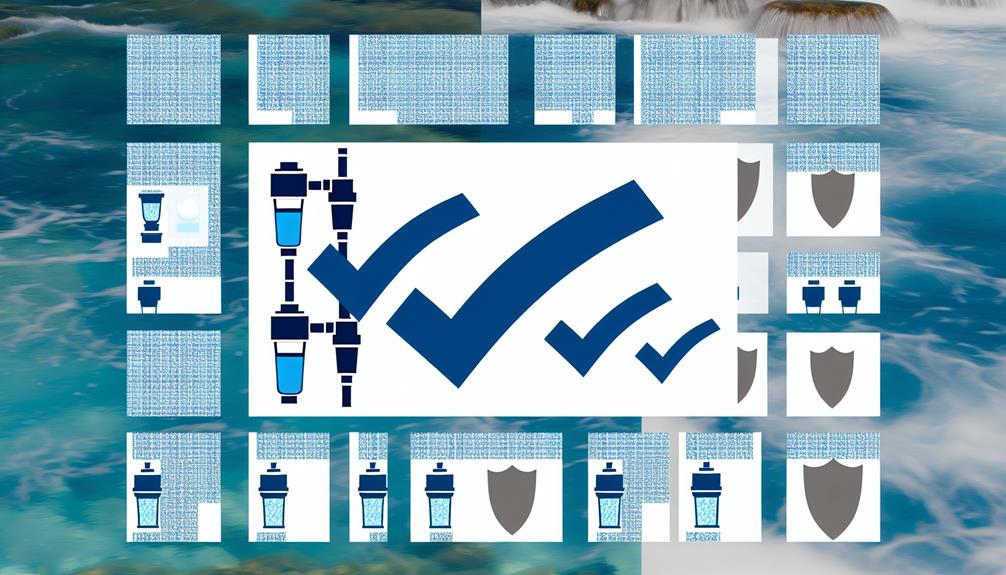You might think that the water flowing from your tap is as pure as the driven snow, but the reality can be startlingly different. Ensuring that the water you drink is free from contaminants is crucial, and this is where home water purifiers come into play.
As you navigate the maze of options available, you'll find that adhering to the highest safety standards isn't just preferable; it's essential for your health. You're about to discover the six paramount safety standards, including NSF certification requirements and ANSI compliance guidelines, that your home water purifier must meet to be considered truly safe.
From understanding the WQA Gold Seal Protocol to grasping the importance of lead-free material regulations, you'll learn what it takes to shield your water from impurities. But remember, the devil is in the details, and knowing these standards is just the tip of the iceberg.
Stay tuned to unveil the critical factors that can make or break the effectiveness of your water purification system.
NSF Certification Requirements
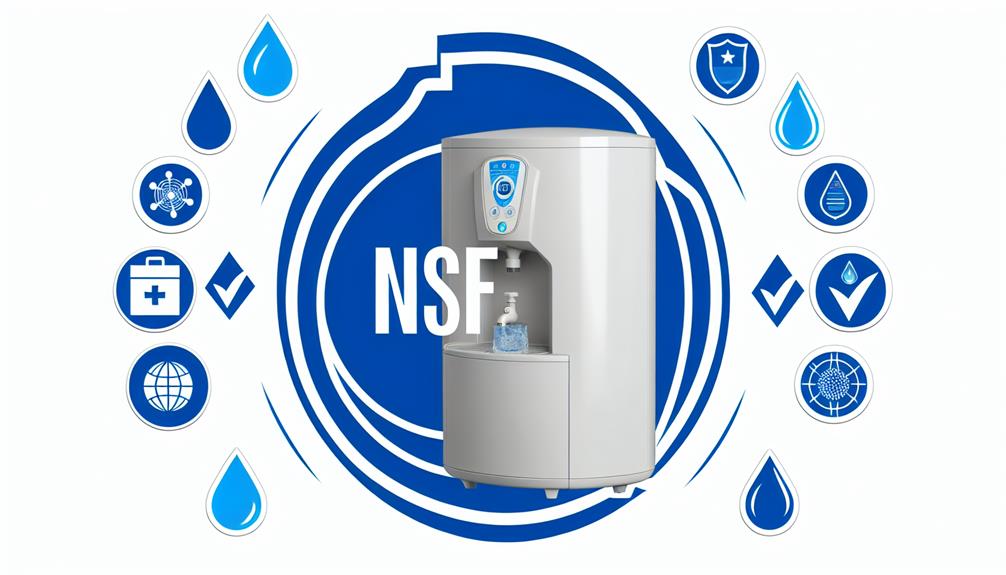
To ensure the safety and performance of home water purifiers, manufacturers must adhere to the stringent NSF certification requirements. This certification not only provides a benchmark for product quality and safety but also establishes a level of consumer trust in the market. The NSF certification process involves rigorous testing and evaluation of water purifiers to confirm that they meet the established public health and safety standards.
You'll find that certification benefits extend beyond mere compliance. It signifies to you, the consumer, that a product has been independently verified for its ability to reduce specific contaminants, as claimed by the manufacturer. Moreover, it ensures that the materials and chemicals used in manufacturing don't leach harmful substances into your water.
Adherence to NSF standards isn't a one-time event. Continuous compliance is monitored through periodic unannounced facility audits and product testing. This comprehensive approach guarantees that the water purifier you rely on continues to meet stringent health and safety requirements over time.
Incorporating NSF certification into product development and marketing strategies can enhance your product's credibility. It's a powerful tool that can differentiate your brand in a competitive market, fostering consumer trust through the promise of certified safety and performance.
ANSI Compliance Guidelines
How do ANSI compliance guidelines shape the safety protocols of your home water purifier?
The American National Standards Institute (ANSI) establishes precise criteria to ensure that water purifiers function safely and effectively. Adhering to these guidelines doesn't just enhance the performance of your device; it also fortifies the trust you place in the water you consume.
Here's how ANSI regulations impact your purifier's operation:
- Material Durability: ANSI compliance mandates that all materials in contact with drinking water must be robust and non-toxic, minimizing the risk of contaminants leaching into your water supply. This ensures that from the moment water enters the purifier to the point of consumption, material integrity is maintained, preventing potential health hazards.
- Testing Frequency: Regular and rigorous testing is at the heart of ANSI protocols. Your purifier is subjected to repeated stress tests to verify that it meets performance standards over time, not just when it's new. This persistent scrutiny guarantees sustained safety and function.
- Certification Updates: ANSI guidelines are dynamic, adapting to new research and technology. Your purifier must comply with the latest standards, which means it's designed with cutting-edge advancements to tackle emerging water quality concerns.
WQA Gold Seal Protocol
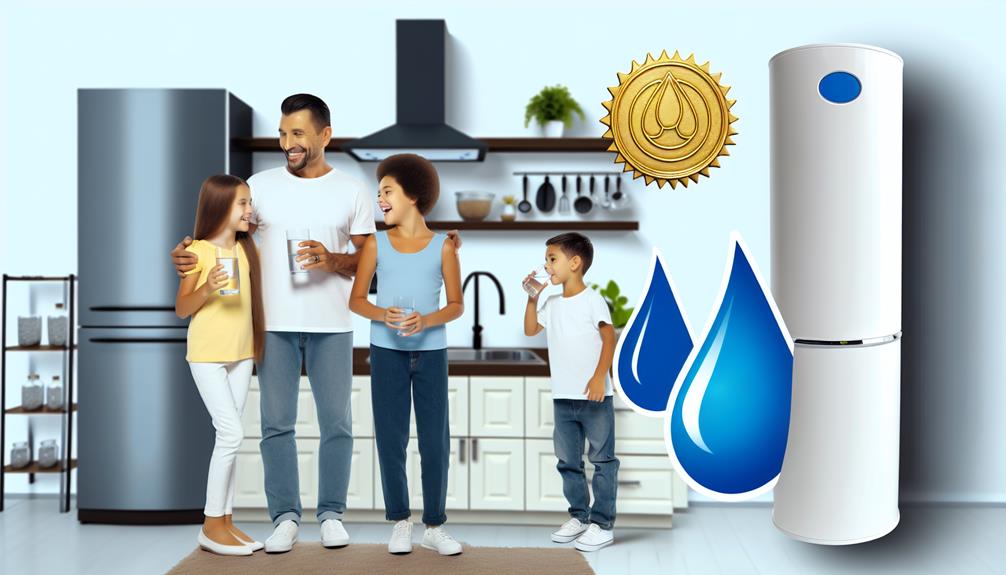
You must understand that the WQA Gold Seal Protocol is a rigorous certification process, ensuring that water purifiers meet specific health and safety standards.
By obtaining the Gold Seal, manufacturers demonstrate their commitment to providing products that are reliable and safe for consumer use.
It's critical to assess how these standards align with your water purification needs to guarantee optimal safety.
Certification Process Explained
Understanding the WQA Gold Seal certification process is crucial for ensuring your home water purifier meets rigorous safety and performance standards. The process specifically evaluates the effectiveness of filtration technology against waterborne pathogens and other contaminants.
Here's what it entails:
- Product Submission: You must submit your water purifier for rigorous testing, which assesses its performance and material safety.
- Laboratory Testing: The purifier undergoes stringent testing against established standards to ensure it effectively reduces contaminants, including waterborne pathogens.
- Manufacturing Facility Audit: Compliance with good manufacturing practices is verified through an on-site audit to maintain consistent product quality.
Achieving the WQA Gold Seal certifies that your water purifier operates with exceptional precision, safeguarding your water supply from diverse contaminants.
Importance of Gold Seal
Having explained the WQA Gold Seal certification process, it's clear that this distinction plays a pivotal role in ensuring your home water purifier adheres to the highest safety and performance benchmarks.
The Gold Seal isn't just a badge; it's a rigorous verification of filtration efficacy, critical in the face of waterborne diseases. This seal signifies that your purifier has been tested against stringent standards, reducing the risk of contaminants compromising your water quality.
It's about peace of mind, knowing that the system you rely on for clean water performs as promised. When you see the Gold Seal, you're assured that the product meets or exceeds industry expectations for contaminant reduction, structural integrity, and material safety, minimizing potential health risks associated with impure water.
Meeting Health Safety Criteria
To obtain the WQA Gold Seal, a home water purifier must satisfy rigorous health safety criteria, ensuring that each system efficiently removes specific contaminants as per established guidelines. The WQA's protocol is technical and precise, focused on the following:
- Verification of Contaminant Reduction: The purifier must demonstrate purification effectiveness, meeting or exceeding health benchmarks for contaminant reduction.
- Structural Integrity Testing: The system is subjected to pressure fluctuations and stress to ensure durability and prevent leakage or contamination.
- Material Safety Assessment: All materials in contact with the water are scrutinized for toxicity and mustn't leach harmful substances into the purified water.
These criteria are essential to certify that a home water purifier not only performs reliably but also maintains the health and safety of users.
EPA Water Testing Standards
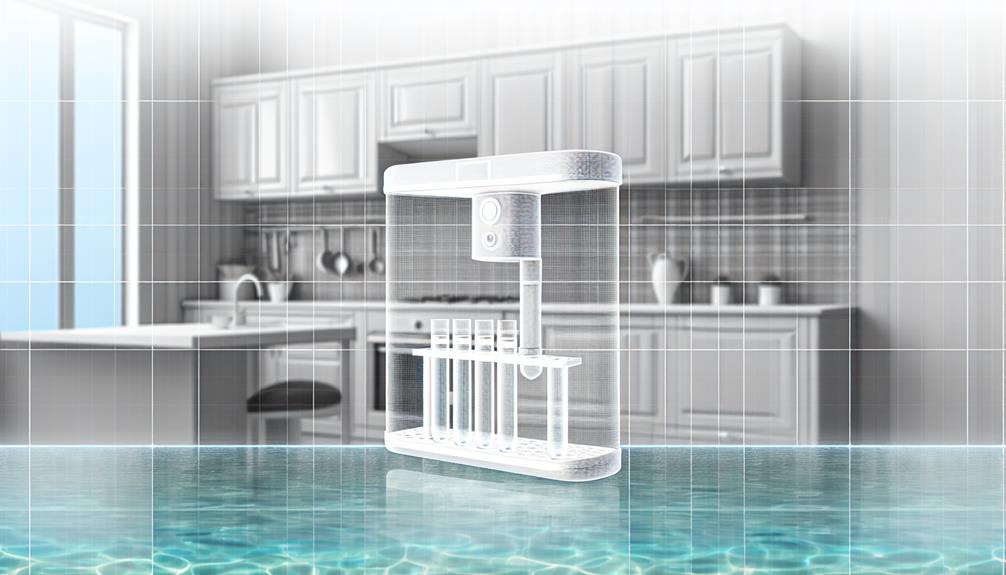
The Environmental Protection Agency (EPA) sets rigorous standards for water testing to ensure that tap water is safe for consumption. These standards specify acceptable contaminant levels in drinking water to minimize health risks.
As you seek to comply with these standards for your home water purifier, you must understand the precise thresholds determined by the EPA for various contaminants, including microorganisms, disinfectants, and their byproducts, inorganic chemicals, and organic chemicals.
To accurately assess contaminant levels, the EPA mandates that all testing be performed by laboratories with proper accreditation. This accreditation ensures that the laboratories have the capability to conduct accurate and reliable testing, adhering to standardized methods and quality control procedures.
You're expected to engage only with laboratories that maintain such accreditation to validate the efficacy of your home water purifier against EPA benchmarks.
In your analysis of water purifiers, prioritize units that demonstrate the ability to consistently produce water meeting or exceeding these contaminant levels. Furthermore, familiarize yourself with the testing protocols and frequency recommended by the EPA, as they can vary depending on the specific contaminant and its potential health impact.
ISO Quality Management Principles
You must ensure your home water purifiers meet ISO quality management principles to align with global safety standards. ISO compliance underscores the relevance of adopting a framework for consistent product quality.
This framework includes a continuous improvement cycle that's integral for maintaining high-performance water purification systems.
ISO Compliance Relevance
Understanding ISO compliance is crucial as it ensures that home water purifiers meet international safety and quality management standards. Your device's adherence to these benchmarks is non-negotiable for several reasons:
- Regulatory Audits: ISO compliance facilitates regular assessments by authorities, ensuring continuous adherence to high-quality standards.
- Market Surveillance: Compliance helps your product withstand the scrutiny of market surveillance, affirming its reliability and safety for consumers.
- Customer Trust: It establishes your brand's reputation for quality and safety, directly influencing customer trust and preference.
ISO's stringent criteria serve as a framework for the production and testing of home water purifiers. By following these guidelines, you can ascertain that your product not only meets regulatory demands but also exceeds consumer expectations for purity and safety.
Continuous Improvement Cycle
Building on the foundation of ISO compliance, let's examine how the Continuous Improvement Cycle forms a core aspect of the ISO Quality Management Principles, driving manufacturers to perpetually enhance the performance and safety of home water purifiers.
This cycle mandates a systematic approach to quality monitoring, ensuring that every product not only meets but strives to exceed established safety benchmarks. You must engage in rigorous performance assessment, analyzing data to identify potential areas for improvement.
This analysis leads to the implementation of targeted actions aimed at optimizing product quality and reliability. By embracing this cycle, you ensure that your water purifiers are subject to an evolving standard of excellence, reflecting the latest in technological advancements and consumer expectations.
Lead-Free Material Regulations
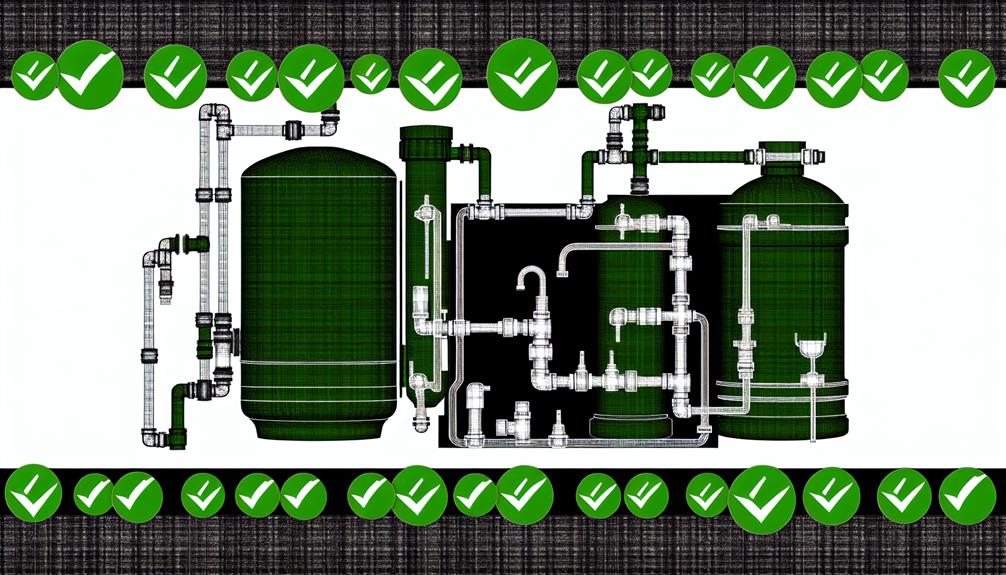
In the realm of home water purifiers, lead-free material regulations play a critical role in ensuring your water supply remains uncontaminated by this toxic metal. Material toxicity poses significant risks to health, and regulatory oversight is essential in mitigating these dangers.
As you select a water purifier, it's crucial to understand how these regulations protect you:
- National Standards Compliance: Your water purifier should meet or exceed national standards for lead content. In the United States, for instance, the Safe Drinking Water Act (SDWA) Amendment of 1986 and subsequent revisions strictly limit the percentage of lead in materials that come into contact with drinking water.
- Certification by Recognized Bodies: Look for products certified by recognized authorities such as NSF International or the Water Quality Association, ensuring the materials used are rigorously tested for lead leaching and are within safe limits.
- Regular Audits and Testing: Manufacturers must undergo regular audits to confirm continued compliance with lead-free standards. This includes periodic testing of the products to ensure they maintain low lead levels throughout their operational life.
Conclusion
In conclusion, you must ensure your home water purifier adheres to key safety standards. Verify NSF Certification, meet ANSI Compliance Guidelines, and seek the WQA Gold Seal for assured purification efficacy. Adhere to EPA's rigorous water testing norms and embrace ISO's quality management principles for consistent performance.
Importantly, insist on lead-free materials to mitigate contamination risks. These technical benchmarks are crucial for the reliable, safe, and effective operation of your water purification system.
